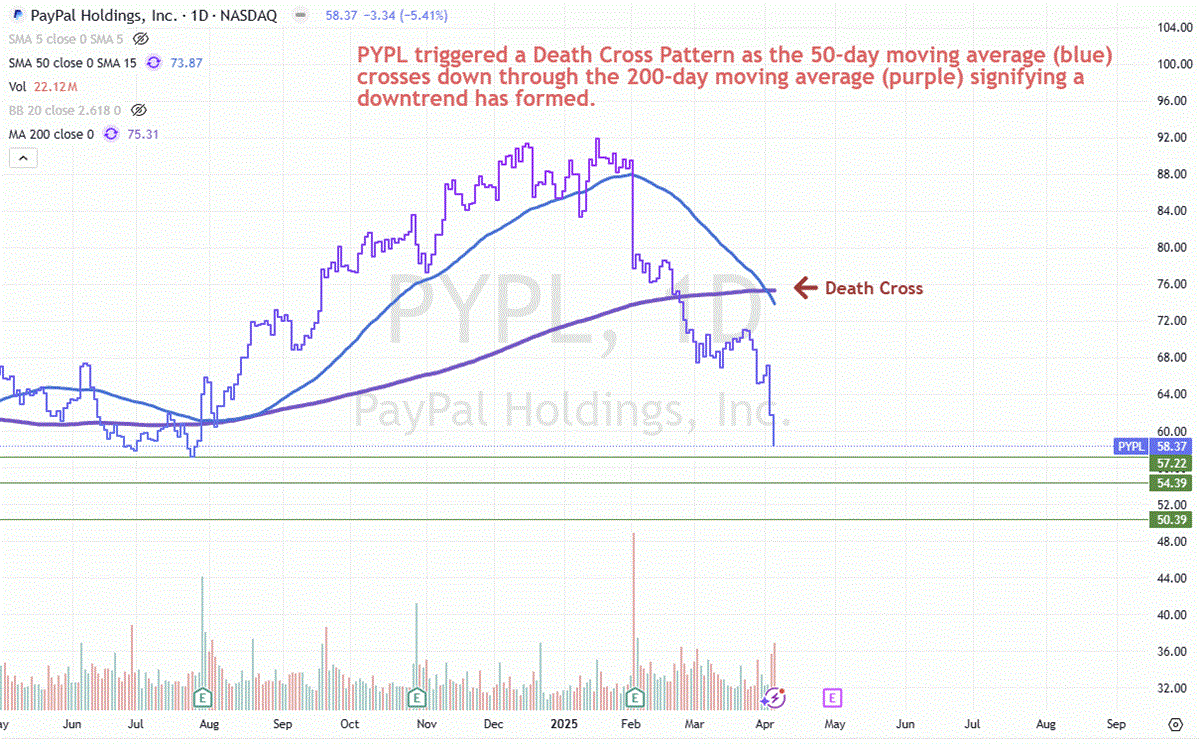PayPal (NASDAQ:PYPL) Holdings shares have not only entered bear market territory but also triggered a Death Cross pattern on their price chart.
The stock has become very bearish to the point of becoming too cheap to ignore.
The computer and technology sector is being slapped the hardest during the market sell-off.
The tech-heavy NASDAQ is entering bear market territory, as measured by the Invesco QQQ Trust (NASDAQ:QQQ), falling 21.85% from its highs as of Apr. 3, 2025.
With such bearishness, could it be an opportunity to buy into shares?
PayPal Is a Cash Flow Machine, Still Growing in 2024
PayPal reminded investors why it's still a cash flow powerhouse in 2024. The digital payments giant generated $6.8 billion in free cash flow for the year, up sharply from $4.2 billion in 2023. In Q4 alone, PayPal posted earnings per share (EPS) of $1.19, beating estimates by 7 cents, while revenue rose 4.2% year-over-year (YOY) to $8.37 billion, topping forecasts. Total payment volume (TPV) grew 7% YOY to $437.8 billion in the quarter and hit $1.68 trillion for the full year—a 10% increase.
Despite a 3% dip in payment transaction volume (PTV) during Q4 to 6.6 billion, full-year PTV climbed 5% to 26.3 billion. Meanwhile, PayPal’s user base continued to expand, adding 8.8 million active accounts to reach 434 million, with users making 3% more transactions on average. The company ended the quarter with $15.1 billion in cash and $11.1 billion in total debt, giving it plenty of financial firepower. In the competitive world of digital commerce payments, where it battles rivals like Block (NYSE:XYZ), PayPal’s scale, steady growth, and cash generation keep it firmly in the game.
PayPal Raised Its Forward Guidance for 2025
PayPal exited 2024 in a strong position, as evidenced by its upside guidance for both the next quarter and next year. For Q1 2025, the company guided EPS from $1.15 to $1.17, with a midpoint of $1.16 versus $1.13 consensus estimates. For the full year 2025, PayPal guided EPS of $4.95 to $5.10, with a midpoint of $5.03 versus $4.90 consensus estimates.
PayPal also announced a $15 billion stock buyback program in addition to the remaining $4.86 billion left from its 2022 stock buyback program.
Valuation Metrics Have Gotten Extreme
From a valuation standpoint, PayPal looks relatively cheap. The stock trades at a price-to-earnings (P/E) ratio of 14.58 and a forward P/E of 11.6—both well below the financial transaction services industry average of 23.28 as of Apr. 3, 2025. It also trades lower than the S&P 500 financials sector average P/E of 17.46. PayPal’s price-to-free cash flow (P/FCF) sits at 13.88, and its price-to-sales (P/S) ratio is just 1.82, suggesting the market is heavily discounting its future growth potential.
PayPal’s Treasury Stock Holdings Have Grown to $18.5 Billion
Investors often wonder what happens to the stock that companies buy back. After repurchase programs, shares are either permanently retired or held as treasury stock. In PayPal’s case, the company holds its repurchased shares in treasury—they haven’t retired any.
Unfortunately, PayPal stock has had a rough stretch, falling 17% year-to-date (YTD). As of the end of 2024, PayPal’s 10-K showed $27.09 billion worth of treasury stock, based on a year-end price of $85.35. That translates to about 317.34 million shares. Fast forward to Apr. 3, 2025, and with the stock down to $58.37, the value of PayPal’s treasury stock has dropped to $18.49 billion.
While treasury stock doesn’t count as an asset or as part of the outstanding share count, it still gives companies flexibility. Treasury shares can be used for acquisitions, stock option plans, or restricted stock units (RSUs), all without diluting current shareholders. By tapping into treasury shares instead of issuing new stock, PayPal can help offset the dilution that often comes with employee compensation—a quiet but important shareholder benefit.
Resilience to U.S. Tariff Impacts
PayPal earns revenue from transactions as a service for processing payments. Because it doesn’t import goods, it is not directly impacted by U.S. tariffs. Its global payment volume has grown.
While the U.S. has the largest customer base, it has been expanding its reach with cross-border payments. In Q4, PayPal's cross-border payment volume was 13% of TPV or $56.9 billion. Of course, if trade wars cause a drop in imports, this could negatively impact cross-border transaction volume in 2025.
